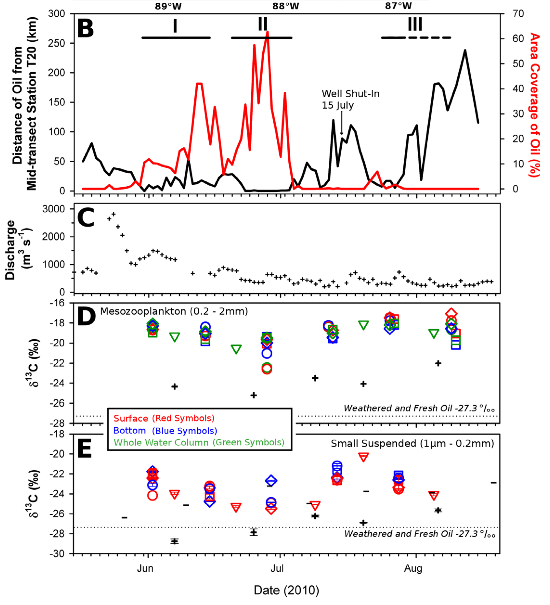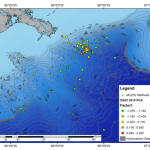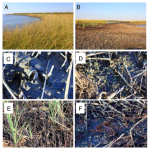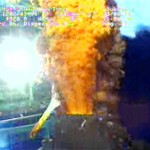A new study released today shows the first evidence of Deepwater Horizon oil entering planktonic food webs in the Gulf of Mexico (is anyone surprised? No? Didn’t think so. ). Researchers from Dauphin Island Sea lab and the University of South Alabama tracked levels of δ13C across different size classes of plankton, looking for depleted levels of this isotope to signal biological uptake of hydrocarbons from Sweet Louisiana Crude oil. Depletion of δ13C can also be caused by increased freshwater input (e.g. from nearby Mobile Bay), phytoplankton blooms, or even physical presence of oil in the water column. However, the researchers were able to rule out all these possible causes for isotope depletion–bay outflow was low during the sampling period, chlorophyll in the water column was not especially high, and direct oil contamination could be ruled out by normal C:N ratios (which would be ‘anomalously’ high if micro-droplets of oil were present in the water or attached to the exterior of plankton).
For now, I’ll leave you with a figure which really says it all–depletion of δ13C isotopes was apparently synced with northward pulses of surface oil slicks. The lowered δ13C values were also observed across different size classes of plankton, supporting the rapid and broadscale integration of oil hydrocarbons into the food chain.

Since we know that microbes ingest oil, and now plankton apparently do too, one must ask–how long until we start finding Deepwater Horizon hydrocarbons in our secondary and tertiary consumers??
Reference:
Graham, W., Condon, R., Carmichael, R., D’Ambra, I., Patterson, H., Linn, L., & Hernandez Jr, F. (2010). Oil carbon entered the coastal planktonic food web during the Deepwater Horizon oil spill Environmental Research Letters, 5 (4) DOI: 10.1088/1748-9326/5/4/045301






So, could you explain for the non-marine biology people like me… if the plankton are ingesting them, does their digestion break the hydrocarbons down at all (like microbes do), or does it just become incorporated into their tissues, and passed on to whatever eats the plankton? Thanks, DeLene
What this graph is showing very nicely (but very hard to see if you are not used to this sort of thing) is that the d13C signature of the plankton decreased when there was a big influx of oil shoreward. What this means for the animals the study looked at is that there d13C stable isotope values were being pulled “more negatively”. Because the signature of the oil is more negative than the signature of the plankton’s main food source, we can infer that the plankton are acquiring the oil in their diet somehow.
The oil would be ingested and the carbon broken down and recycled into the animal’s tissue. Tissue does turnover relatively quickly. I don’t know how fast in small plankton, but many larger organisms take on the order of a couple months to turn over muscle tissue. This means that when the researchers caught the plankton, they are looking at a very recent signature of their last meals in d13C. Since oil has much more 12C than 13C (i.e. is lighter) than other food sources for the plankton, the data shows us that they are incorporating carbon derived from the oil into their tissue. Its not broken down, but recycled. And this scales up the food web.
Does this help?
Yes – thank you, Kevin. Guess this is where neophytes like me need a verbal interpretation of posted graphs.
Delene, Thanks for commenting and posting questions. We greatly welcome them. It is often too easy for us as scientists trying to communicate to the public to fall in trap of not providing enough explanations. Thanks for watch guarding!